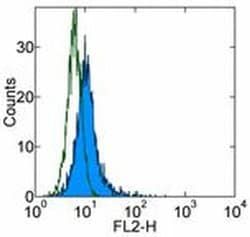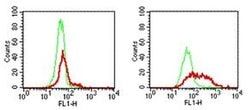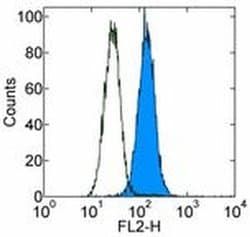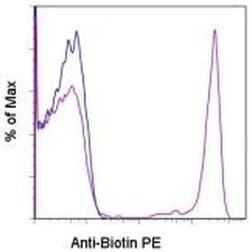50-112-51
CD289 (TLR9) Monoclonal Antibody (eB72-1665), PE, eBioscience™, Invitrogen™
Manufacturer: Invitrogen
Select a Size
| Pack Size | SKU | Availability | Price |
|---|---|---|---|
| Each of 1 | 50-112-51-Each-of-1 | In Stock | ₹ 39,338.00 |
50-112-51 - Each of 1
In Stock
Quantity
1
Base Price: ₹ 39,338.00
GST (18%): ₹ 7,080.84
Total Price: ₹ 46,418.84
Antigen
CD289 (TLR9)
Classification
Monoclonal
Concentration
0.2 mg/mL
Formulation
PBS with 0.1% gelatin and 0.09% sodium azide; pH 7.2
Gene Accession No.
Q9NR96
Gene Symbols
TLR9
Purification Method
Affinity chromatography
Regulatory Status
RUO
Gene ID (Entrez)
54106
Content And Storage
4° C, store in dark, DO NOT FREEZE!
Form
Liquid
Applications
Flow Cytometry
Clone
eB72-1665
Conjugate
PE
Gene
TLR9
Gene Alias
Toll-like Receptor 9; Toll-like receptor 9 protein; UNQ5798/PRO19605
Host Species
Rat
Quantity
100 μg
Primary or Secondary
Primary
Target Species
Human
Product Type
Antibody
Isotype
IgG2a κ
Description
- Description: eB72-1665 is generated against a portion of human toll-like receptor 9 (aa 273-288), a molecule reported to be expressed predomitly intracellularly
- TLR9 is a ∽115-120 kDa molecule, which mediates response to unmethylated CpG dinucleotides in bacterial DNA
- CpG DNA induces a strong T-helper-1-like inflammatory response and the proliferation of TLR9-positive human B cells
- When stimulated with CpG DNA, TLR9-deficient (TLR9-/-) mice lacked splenocyte proliferation, inflammatory cytokine production from macrophages, and dendritic cell maturation, as compared with normal mice
- To date, at least twelve members of the Toll family have been identified
- This family of type I transmembrane proteins is characterized by an extracellular domain with leucine-rich repeats and a cytoplasmic domain with homology to the type I IL-1 receptor
- Members of the TLR family are involved in recognition and response to different microbial components including lipoproteins, peptidoglycans, and nucleic acids and play important roles in innate immunity and inflammation
- TLR9 is not detected by flow cytometry using this antibody on lysed whole human blood and/or isolated human PBMC stained for cell surface or intracellular TLR9
- This may be due to limitations of antigen detection by flow cytometry
- Human pDCs matured in the presence of IL-3 have been reported to stain with eB72-1665 by immunofluorescence microscopy (Nat Immunol
- 5:190)
- Human Epithelial Cell lines were also reported to stain with this mAb (J
- Immunol
- 173: 1219)
- Further studies are needed to determine the relationship between mRNA expression and protein detection by flow cytometry
- Applications Reported: This eB72-1665 antibody has been reported for use in intracellular flow cytometric analysis
- Applications Tested: This eB72-1665 antibody has been tested by intracellular flow cytometric analysis of hTLR9 transfected cells
- This can be used at less than or equal to 1 µg per test
- A test is defined as the amount (µg) of antibody that will stain a cell sample in a final volume of 100 µL
- Cell number should be determined empirically but can range from 10^5 to 10^8 cells/test
- It is recommended that the antibody be carefully titrated for optimal performance in the assay of interest
- Excitation: 488-561 nm; Emission: 578 nm; Laser: Blue Laser, Green Laser, Yellow-Green Laser
- Filtration: 0.2 μm post-manufacturing filtered
- The protein encoded by this gene is a member of the Toll-like receptor family which plays a fundamental role in pathogen recognition and activation of innate immunity
- TLRs are highly conserved from Drosophila to humans and share structural and functional similarities
- They recognize pathogen-associated molecular patterns that are expressed on infectious agents, and mediate the production of cytokines necessary for the development of effective immunity
- The various TLRs exhibit different patterns of expression
- This gene is preferentially expressed in immune cell rich tissues, such as spleen, lymph node, bone marrow and peripheral blood leukocytes
- Studies in mice and human indicate that this receptor mediates cellular response to unmethylated CpG dinucleotides in bacterial DNA to mount an innate immune response.
Compare Similar Items
Show Difference
Antigen: CD289 (TLR9)
Classification: Monoclonal
Concentration: 0.2 mg/mL
Formulation: PBS with 0.1% gelatin and 0.09% sodium azide; pH 7.2
Gene Accession No.: Q9NR96
Gene Symbols: TLR9
Purification Method: Affinity chromatography
Regulatory Status: RUO
Gene ID (Entrez): 54106
Content And Storage: 4° C, store in dark, DO NOT FREEZE!
Form: Liquid
Applications: Flow Cytometry
Clone: eB72-1665
Conjugate: PE
Gene: TLR9
Gene Alias: Toll-like Receptor 9; Toll-like receptor 9 protein; UNQ5798/PRO19605
Host Species: Rat
Quantity: 100 μg
Primary or Secondary: Primary
Target Species: Human
Product Type: Antibody
Isotype: IgG2a κ
Antigen:
CD289 (TLR9)
Classification:
Monoclonal
Concentration:
0.2 mg/mL
Formulation:
PBS with 0.1% gelatin and 0.09% sodium azide; pH 7.2
Gene Accession No.:
Q9NR96
Gene Symbols:
TLR9
Purification Method:
Affinity chromatography
Regulatory Status:
RUO
Gene ID (Entrez):
54106
Content And Storage:
4° C, store in dark, DO NOT FREEZE!
Form:
Liquid
Applications:
Flow Cytometry
Clone:
eB72-1665
Conjugate:
PE
Gene:
TLR9
Gene Alias:
Toll-like Receptor 9; Toll-like receptor 9 protein; UNQ5798/PRO19605
Host Species:
Rat
Quantity:
100 μg
Primary or Secondary:
Primary
Target Species:
Human
Product Type:
Antibody
Isotype:
IgG2a κ
Antigen: __
Classification: __
Concentration: __
Formulation: __
Gene Accession No.: __
Gene Symbols: __
Purification Method: __
Regulatory Status: __
Gene ID (Entrez): __
Content And Storage: __
Form: __
Applications: __
Clone: __
Conjugate: __
Gene: __
Gene Alias: __
Host Species: __
Quantity: 100 Tests
Primary or Secondary: __
Target Species: __
Product Type: Staining Kit
Isotype: __
Antigen:
__
Classification:
__
Concentration:
__
Formulation:
__
Gene Accession No.:
__
Gene Symbols:
__
Purification Method:
__
Regulatory Status:
__
Gene ID (Entrez):
__
Content And Storage:
__
Form:
__
Applications:
__
Clone:
__
Conjugate:
__
Gene:
__
Gene Alias:
__
Host Species:
__
Quantity:
100 Tests
Primary or Secondary:
__
Target Species:
__
Product Type:
Staining Kit
Isotype:
__
Antigen: __
Classification: __
Concentration: __
Formulation: __
Gene Accession No.: __
Gene Symbols: __
Purification Method: __
Regulatory Status: __
Gene ID (Entrez): __
Content And Storage: 2° to 8°C
Form: __
Applications: __
Clone: __
Conjugate: __
Gene: __
Gene Alias: __
Host Species: __
Quantity: __
Primary or Secondary: __
Target Species: __
Product Type: Biotin Panel
Isotype: __
Antigen:
__
Classification:
__
Concentration:
__
Formulation:
__
Gene Accession No.:
__
Gene Symbols:
__
Purification Method:
__
Regulatory Status:
__
Gene ID (Entrez):
__
Content And Storage:
2° to 8°C
Form:
__
Applications:
__
Clone:
__
Conjugate:
__
Gene:
__
Gene Alias:
__
Host Species:
__
Quantity:
__
Primary or Secondary:
__
Target Species:
__
Product Type:
Biotin Panel
Isotype:
__
Antigen: Galectin 3
Classification: Monoclonal
Concentration: 1 mg/mL
Formulation: PBS with no preservative; pH 7.2-7.4
Gene Accession No.: P17931
Gene Symbols: LGALS3
Purification Method: Affinity chromatography
Regulatory Status: RUO
Gene ID (Entrez): 3958
Content And Storage: -20° C, Avoid Freeze/Thaw Cycles
Form: Liquid
Applications: ELISA, Flow Cytometry, Immunocytochemistry, Immunohistochemistry, Immunoprecipitation, Western Blot
Clone: eBioM3/38 (M3/38)
Conjugate: Unconjugated
Gene: LGALS3
Gene Alias: 35 kDa lectin; advanced glycation end-product receptor 3; AGE-R3; beta-galactosides-binding lectin; carbohydrate-binding protein 35; CBP 35; CBP30; CBP-30; CBP35; epsilon BP; gal3; gal-3; galactose-specific lectin 3; Galactoside-binding protein; GALBP; galectin 3; Galectin3; galectin-3; GALIG; GBP; IgE binding protein; igE-binding protein; L-29; L31; L-31; L-34; L-34 galactoside-binding lectin; Laminin-binding protein; lectin galactoside-binding soluble 3; lectin galactoside-binding soluble 3 protein; lectin L-29; lectin, galactose binding, soluble 3; lectin, galactoside binding soluble 3; lectin, galactoside-binding, soluble, 3; lectin, galactoside-binding, soluble, 3 (galectin 3); LGALS2; Lgals3; MAC2; Mac-2; Mac-2 antigen
Host Species: Rat
Quantity: 100 μg
Primary or Secondary: Primary
Target Species: Human
Product Type: Antibody
Isotype: IgG2a κ
Antigen:
Galectin 3
Classification:
Monoclonal
Concentration:
1 mg/mL
Formulation:
PBS with no preservative; pH 7.2-7.4
Gene Accession No.:
P17931
Gene Symbols:
LGALS3
Purification Method:
Affinity chromatography
Regulatory Status:
RUO
Gene ID (Entrez):
3958
Content And Storage:
-20° C, Avoid Freeze/Thaw Cycles
Form:
Liquid
Applications:
ELISA, Flow Cytometry, Immunocytochemistry, Immunohistochemistry, Immunoprecipitation, Western Blot
Clone:
eBioM3/38 (M3/38)
Conjugate:
Unconjugated
Gene:
LGALS3
Gene Alias:
35 kDa lectin; advanced glycation end-product receptor 3; AGE-R3; beta-galactosides-binding lectin; carbohydrate-binding protein 35; CBP 35; CBP30; CBP-30; CBP35; epsilon BP; gal3; gal-3; galactose-specific lectin 3; Galactoside-binding protein; GALBP; galectin 3; Galectin3; galectin-3; GALIG; GBP; IgE binding protein; igE-binding protein; L-29; L31; L-31; L-34; L-34 galactoside-binding lectin; Laminin-binding protein; lectin galactoside-binding soluble 3; lectin galactoside-binding soluble 3 protein; lectin L-29; lectin, galactose binding, soluble 3; lectin, galactoside binding soluble 3; lectin, galactoside-binding, soluble, 3; lectin, galactoside-binding, soluble, 3 (galectin 3); LGALS2; Lgals3; MAC2; Mac-2; Mac-2 antigen
Host Species:
Rat
Quantity:
100 μg
Primary or Secondary:
Primary
Target Species:
Human
Product Type:
Antibody
Isotype:
IgG2a κ










